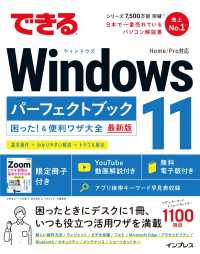Full Description
This innovative work introduces the interdisciplinary field of research of kinesemiotics, offering a new adaptable model and means of analysis for understanding forms of movement-based communication, such as dance, that use a codified language shared by a community of users.
It begins with a theoretical overview and review of existing literature on the main approaches to movement-based communication, specifically dance, which underpin kinesemiotics as an area of study. It reaffirms previous work which established dance as a form of embodied communication in that it encompasses a wide range of semiotic styles and forms shared by communities of "speakers." In collaboration with the English National Ballet, Maiorani employs the genre of ballet as a means through which to understand and analyse some of the key concepts of kinesemiotics, mainly that of space as a semiotic dimension and "motivated movement," or movement with meaning. Supported by automated movement recognition tools from the fields of bio-robotics engineering and computer science, Maiorani argues for ballet's capacity, when movements are projected into meaningful space, to extend beyond sequences of physical movements to become a meaning making practice.
Kinesemiotics advances interdisciplinary research in the fields of social semiotics, media and communication, multimodality, linguistics, and performance studies and will be of particular interest to students and scholars in these areas.
Contents
Preface and Acknowledgements
Introduction
What is Kinesemiotics?
Chapter I - How to capture dance discourse?
Dance notation systems: what they do and do not do.
Dance as a language: the approach of dance studies, kinesthetics and cognitive sciences to movement-based communication.
A socio-semiotic approach to dance: the theoretical background of Kinesemiotics.
CHAPTER 2 - Basic concepts in Kinesemiotics
Kinesemiotics and the human body in space.
Space as a Semiotic Dimension
Motivated Movement as Projection and the Idea of Dance Discourse
The Functional Grammar of Dance model
Dance as a Mode
Dance language: system, instantiation and realization
Dance Discourse and Music
Chapter 3 - An introduction to manual analysis with the FGD.
Introduction to the analysis
Body parts movement possibilities in the FGD system
Comparative examples of manual analysis of moves and sequences.
Dance discourse and the music score.
Chapter 4 - The path to automated analysis: a series experiments with the English National Ballet
Why automated analysis? Reasons and prospects for developing digital recognition of dance discourse.
The experiment protocol
Open-ended conclusions
Bibliography
Index
-

- 電子書籍
- ユウォルの恋愛【タテヨミ】第13話 p…
-

- 電子書籍
- リベンジウェディング【タテヨミ】第30…
-

- 電子書籍
- できるWindows 11 パーフェク…
-

- 電子書籍
- シジュウカラ 分冊版 26 ジュールコ…
-

- 電子書籍
- 男弐3巻 マンガの金字塔



